2016 Hyundai H350 child seat
[x] Cancel search: child seatPage 43 of 473
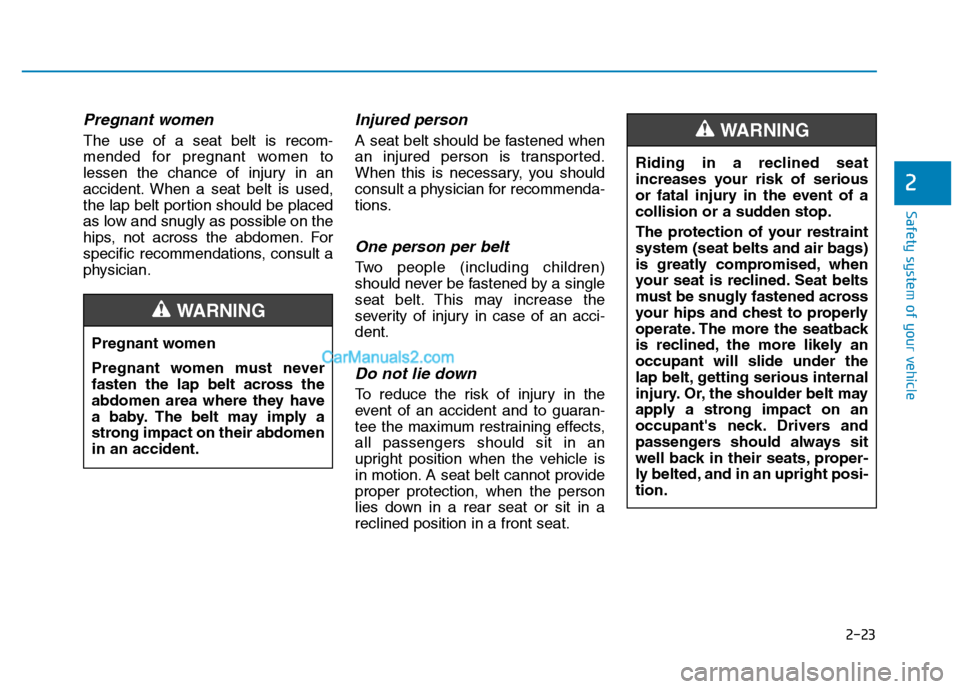
2-23
Safety system of your vehicle
2
Pregnant women
The use of a seat belt is recom-
mended for pregnant women to
lessen the chance of injury in an
accident. When a seat belt is used,
the lap belt portion should be placed
as low and snugly as possible on the
hips, not across the abdomen. For
specific recommendations, consult a
physician.
Injured person
A seat belt should be fastened when
an injured person is transported.
When this is necessary, you should
consult a physician for recommenda-
tions.
One person per belt
Two people (including children)
should never be fastened by a single
seat belt. This may increase the
severity of injury in case of an acci-dent.
Do not lie down
To reduce the risk of injury in the
event of an accident and to guaran-
tee the maximum restraining effects,all passengers should sit in an
upright position when the vehicle is
in motion. A seat belt cannot provideproper protection, when the person
lies down in a rear seat or sit in areclined position in a front seat.
Pregnant women
Pregnant women must never
fasten the lap belt across the
abdomen area where they have
a baby. The belt may imply a
strong impact on their abdomenin an accident.
WARNING
Riding in a reclined seat
increases your risk of serious
or fatal injury in the event of a
collision or a sudden stop.
The protection of your restraint
system (seat belts and air bags)
is greatly compromised, when
your seat is reclined. Seat belts
must be snugly fastened across
your hips and chest to properly
operate. The more the seatback
is reclined, the more likely anoccupant will slide under the
lap belt, getting serious internal
injury. Or, the shoulder belt may
apply a strong impact on an
occupant's neck. Drivers and
passengers should always sit
well back in their seats, proper-
ly belted, and in an upright posi-tion.
WARNING
Page 47 of 473

2-27
Safety system of your vehicle
2
Noise and smoke
When the air bags inflate, they make
a loud noise, leaving smoke and
powder inside the vehicle. This is
normal and is a result of the ignition
of the air bag inflator.
After the air bag inflates, you may
feel substantial discomfort in breath-
ing due to the contact of your chestwith both the seat belt and the air
bag, as well as due to the inhaled
smoke and powder.Immediately
open the doors/windows after the
inflation of the air bag in order to
reduce discomfort and prevent a
prolonged exposure to the smoke
and powder.
Though the smoke and powder are
non-toxic, they may cause skin irrita-
tion (for eyes, nose and throat, etc).
In this case, immediately wash the
irritated area with cold water. Consult
a doctor, if the symptom persists.
Do not install a child restraint
on the front passenger seat
When the air bags deploy, the
air bag components inside thesteering wheel and/or the
instrument cluster become
extremely hot. To prevent injury,
do not touch the air bag compo-
nents, immediately after an air
bag inflates.
WARNING
1JBH3051
OYDESA2042
OLM034310
■ Type B
■
Type A
■ Type C
Page 48 of 473

2-28
Never place a rear-facing child
restraint in the front passenger’s
seat. If the air bag deploys, it would
impact the rear-facing child restraint,
causing serious or fatal injury.
In addition, do not place front-facing
child restraints in the front passen-
ger’s seat either. If the front passen-
ger air bag inflates, it would cause
serious or fatal injuries to the child.
Air bag warning light
The purpose of the air bag warning
light on your instrument cluster is to
alert you of a potential problem with
your air bag - Supplemental
Restraint System (SRS). The warn-
ing light illuminates for approximately
6 seconds, after turning ON the igni-
tion switch. Then, it goes OFF.
Check the system for the below symptoms:
The light does not briefly illumi-
nate, after turning ON the ignition
switch.
The light remains ON longer than approximately 6 seconds.
The light remains ON, when the vehicle is in motion.
Safety system of your vehicle
NEVER use a rearward facing
child restraint on a seat pro-
tected by an ACTIVE AIRBAG
in front of it, DEATH or SERI-
OUS INJURY to the CHILD can
occur.
Never put a child restraint in
the front passenger’s seat. If
the front passenger air bag
inflates, it would cause seri-ous or fatal injuries.
WARNING
W7-147
Page 52 of 473
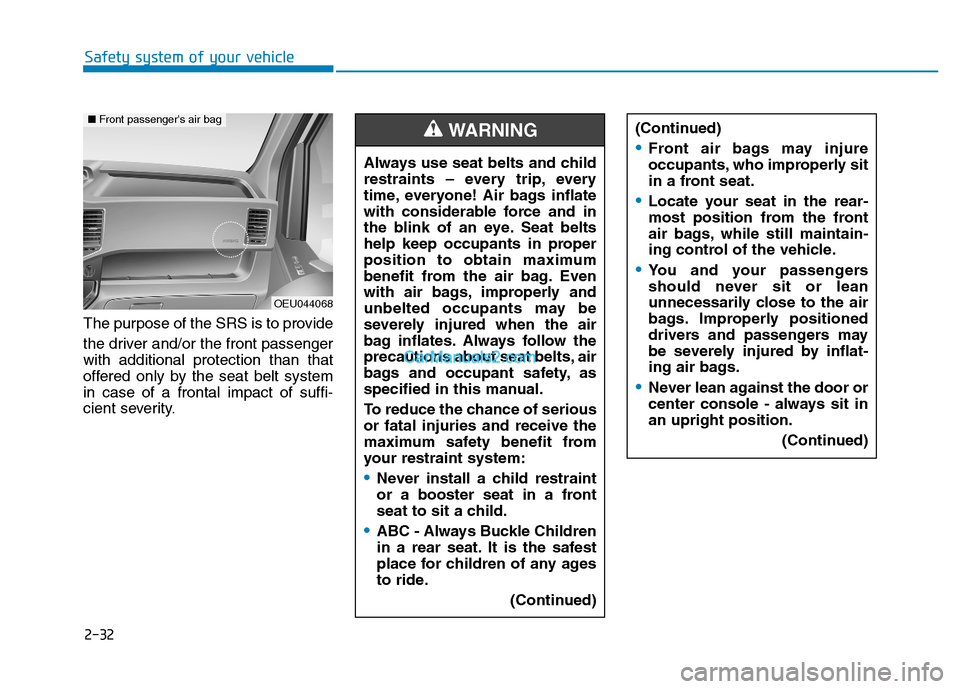
2-32
Safety system of your vehicle
The purpose of the SRS is to provide
the driver and/or the front passenger with additional protection than that
offered only by the seat belt systemin case of a frontal impact of suffi-
cient severity.Always use seat belts and child
restraints – every trip, every
time, everyone! Air bags inflate
with considerable force and in
the blink of an eye. Seat belts
help keep occupants in proper
position to obtain maximum
benefit from the air bag. Even
with air bags, improperly and
unbelted occupants may be
severely injured when the air
bag inflates. Always follow the
precautions about seat belts, air
bags and occupant safety, as
specified in this manual.
To reduce the chance of serious or fatal injuries and receive the
maximum safety benefit from
your restraint system:
Never install a child restraint
or a booster seat in a front
seat to sit a child.
ABC - Always Buckle Children
in a rear seat. It is the safest
place for children of any ages
to ride.
(Continued)
WARNING
OEU044068
■Front passenger's air bag
(Continued)
Front air bags may injure
occupants, who improperly sit
in a front seat.
Locate your seat in the rear-
most position from the front
air bags, while still maintain-
ing control of the vehicle.
You and your passengers
should never sit or lean
unnecessarily close to the air
bags. Improperly positioned
drivers and passengers may
be severely injured by inflat-
ing air bags.
Never lean against the door or
center console - always sit inan upright position.
(Continued)
Page 54 of 473
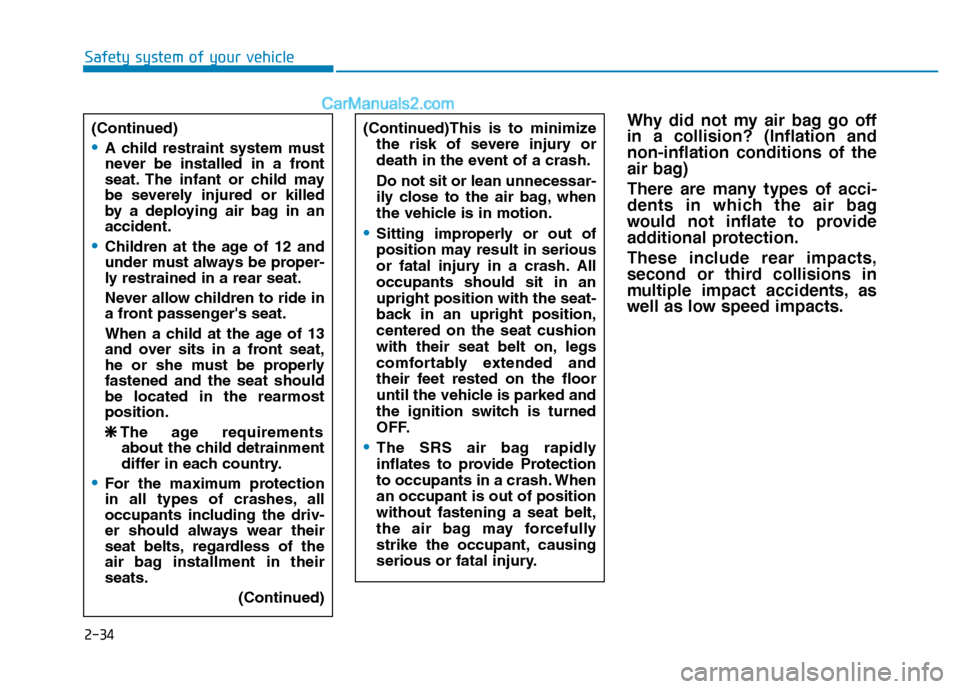
2-34
Safety system of your vehicle
Why did not my air bag go off in a collision? (Inflation andnon-inflation conditions of the
air bag)
There are many types of acci-
dents in which the air bag
would not inflate to provide
additional protection.
These include rear impacts,
second or third collisions in
multiple impact accidents, as
well as low speed impacts.
(Continued)
A child restraint system must
never be installed in a front
seat. The infant or child may
be severely injured or killed
by a deploying air bag in anaccident.
Children at the age of 12 and
under must always be proper-
ly restrained in a rear seat.
Never allow children to ride in
a front passenger's seat.
When a child at the age of 13
and over sits in a front seat,
he or she must be properlyfastened and the seat shouldbe located in the rearmostposition.
❇
❇ The age requirements
about the child detrainment
differ in each country.
For the maximum protection
in all types of crashes, all
occupants including the driv-
er should always wear their
seat belts, regardless of the
air bag installment in theirseats.
(Continued)
(Continued)This is to minimizethe risk of severe injury or
death in the event of a crash. Do not sit or lean unnecessar-
ily close to the air bag, when
the vehicle is in motion.
Sitting improperly or out of
position may result in serious
or fatal injury in a crash. Alloccupants should sit in anupright position with the seat-
back in an upright position,centered on the seat cushion
with their seat belt on, legs
comfortably extended and
their feet rested on the floor
until the vehicle is parked and
the ignition switch is turned
OFF.
The SRS air bag rapidly
inflates to provide Protection
to occupants in a crash. Whenan occupant is out of positionwithout fastening a seat belt,
the air bag may forcefully
strike the occupant, causing
serious or fatal injury.
Page 61 of 473
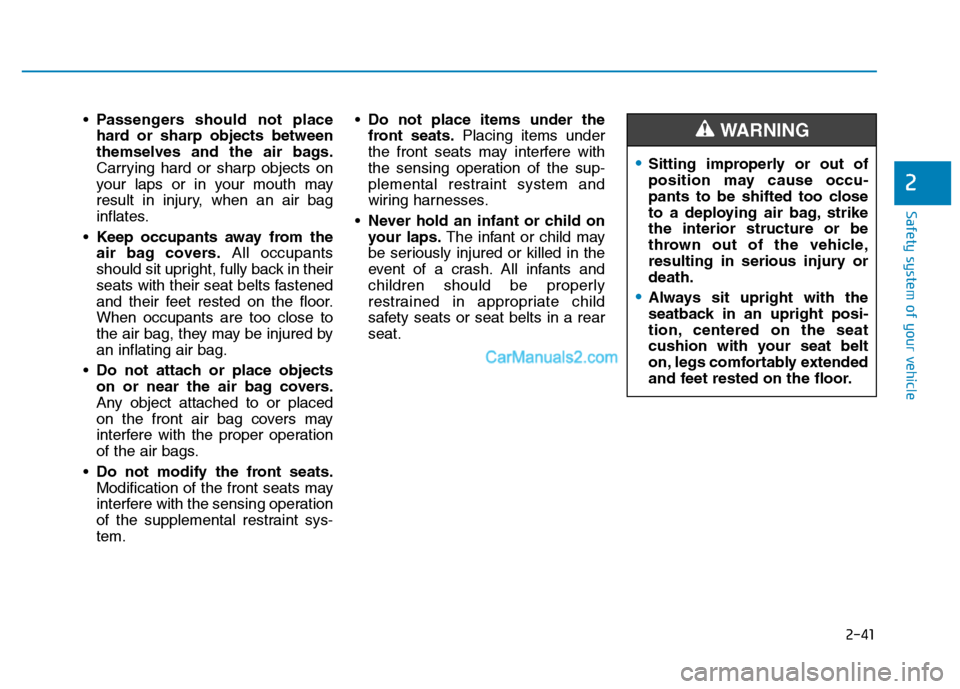
2-41
Safety system of your vehicle
2
Passengers should not place
hard or sharp objects between
themselves and the air bags.
Carrying hard or sharp objects on
your laps or in your mouth may
result in injury, when an air bag
inflates.
Keep occupants away from the
air bag covers. All occupants
should sit upright, fully back in their
seats with their seat belts fastened
and their feet rested on the floor.When occupants are too close to
the air bag, they may be injured byan inflating air bag.
Do not attach or place objects
on or near the air bag covers.
Any object attached to or placed
on the front air bag covers may
interfere with the proper operation
of the air bags.
Do not modify the front seats.
Modification of the front seats may
interfere with the sensing operation
of the supplemental restraint sys-tem.
Do not place items under the
front seats. Placing items under
the front seats may interfere with
the sensing operation of the sup-
plemental restraint system and
wiring harnesses.
Never hold an infant or child on
your laps. The infant or child may
be seriously injured or killed in the
event of a crash. All infants and
children should be properly
restrained in appropriate child
safety seats or seat belts in a rearseat.
Sitting improperly or out of
position may cause occu-
pants to be shifted too close
to a deploying air bag, strikethe interior structure or be
thrown out of the vehicle,
resulting in serious injury ordeath.
Always sit upright with the
seatback in an upright posi-
tion, centered on the seat
cushion with your seat belt
on, legs comfortably extended
and feet rested on the floor.
WARNING
Page 63 of 473
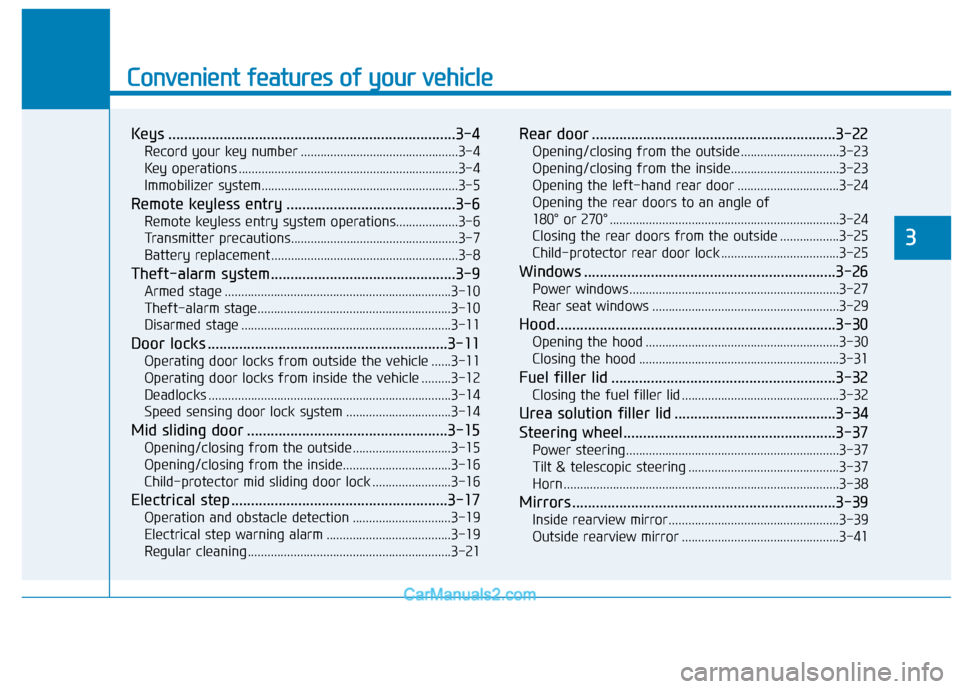
Convenient features of your vehicle
Keys .........................................................................3-4Record your key number ................................................3-4
Key operations ...................................................................3-4
Immobilizer system............................................................3-5
Remote keyless entry ...........................................3-6 Remote keyless entry system operations...................3-6
Transmitter precautions...................................................3-7
Battery replacement .........................................................3-8
Theft-alarm system...............................................3-9 Armed stage .....................................................................3-10
Theft-alarm stage...........................................................3-10
Disarmed stage ................................................................3-11
Door locks .............................................................3-11 Operating door locks from outside the vehicle ......3-11
Operating door locks from inside the vehicle .........3-12
Deadlocks ..........................................................................3-14
Speed sensing door lock system ................................3-14
Mid sliding door ...................................................3-15 Opening/closing from the outside..............................3-15
Opening/closing from the inside.................................3-16
Child-protector mid sliding door lock ........................3-16
Electrical step .......................................................3-17 Operation and obstacle detection ..............................3-19
Electrical step warning alarm ......................................3-19
Regular cleaning ..............................................................3-21 Rear door ..............................................................3-22
Opening/closing from the outside..............................3-23
Opening/closing from the inside.................................3-23
Opening the left-hand rear door ...............................3-24
Opening the rear doors to an angle of
180° or 270° ......................................................................3-24 Closing the rear doors from the outside ..................3-25
Child-protector rear door lock ....................................3-25
Windows ................................................................3-26 Power windows ................................................................3-27
Rear seat windows .........................................................3-29
Hood.......................................................................3-30 Opening the hood ...........................................................3-30
Closing the hood .............................................................3-31
Fuel filler lid .........................................................3-32 Closing the fuel filler lid ................................................3-32
Urea solution filler lid .........................................3-34
Steering wheel......................................................3-37 Power steering.................................................................3-37
Tilt & telescopic steering ..............................................3-37
Horn ....................................................................................3-38
Mirrors ...................................................................3-39 Inside rearview mirror....................................................3-39
Outside rearview mirror ................................................3-41
3
Page 275 of 473
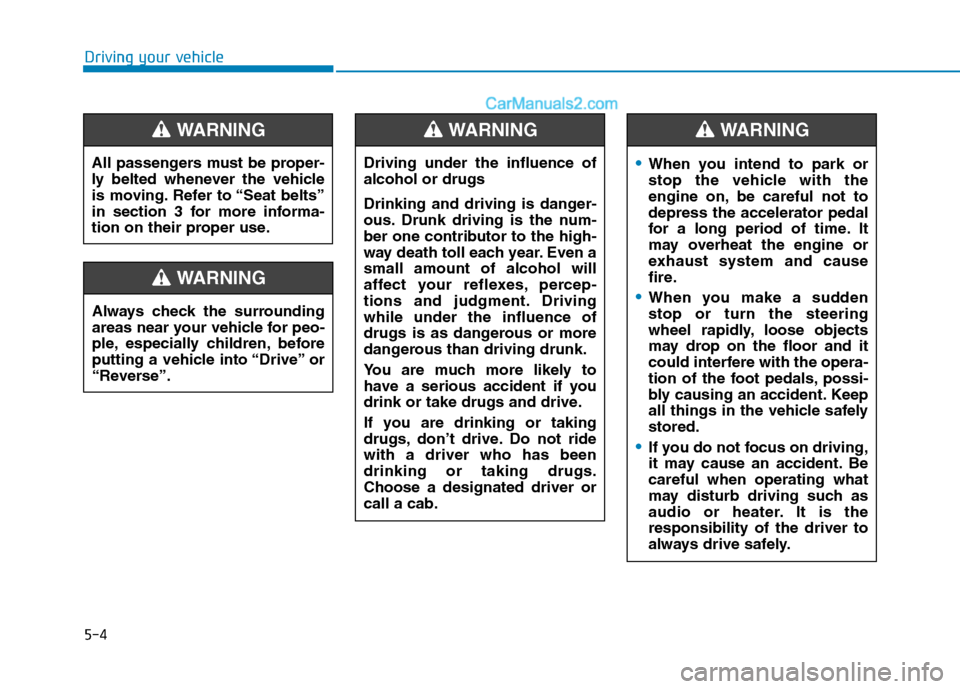
5-4
Driving your vehicle
Always check the surrounding
areas near your vehicle for peo-
ple, especially children, before
putting a vehicle into “Drive” or
“Reverse”.
WARNING
Driving under the influence of alcohol or drugs
Drinking and driving is danger-
ous. Drunk driving is the num-
ber one contributor to the high-
way death toll each year. Even asmall amount of alcohol will
affect your reflexes, percep-
tions and judgment. Drivingwhile under the influence of
drugs is as dangerous or more
dangerous than driving drunk.
You are much more likely to
have a serious accident if you
drink or take drugs and drive.
If you are drinking or taking
drugs, don’t drive. Do not ridewith a driver who has beendrinking or taking drugs.Choose a designated driver orcall a cab.
WARNING
All passengers must be proper-
ly belted whenever the vehicle
is moving. Refer to “Seat belts”
in section 3 for more informa-
tion on their proper use.
WARNING
When you intend to park or
stop the vehicle with the
engine on, be careful not todepress the accelerator pedal
for a long period of time. It
may overheat the engine or
exhaust system and cause
fire.
When you make a sudden stop or turn the steering
wheel rapidly, loose objects
may drop on the floor and it
could interfere with the opera-
tion of the foot pedals, possi-
bly causing an accident. Keep
all things in the vehicle safelystored.
If you do not focus on driving,
it may cause an accident. Becareful when operating what
may disturb driving such as
audio or heater. It is theresponsibility of the driver to
always drive safely.
WARNING